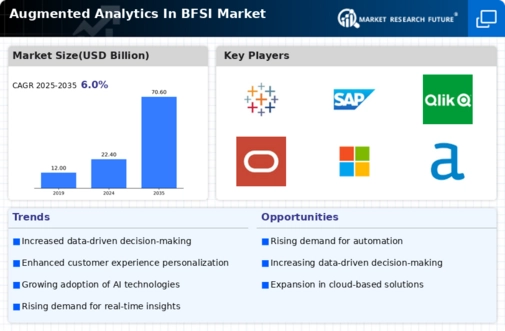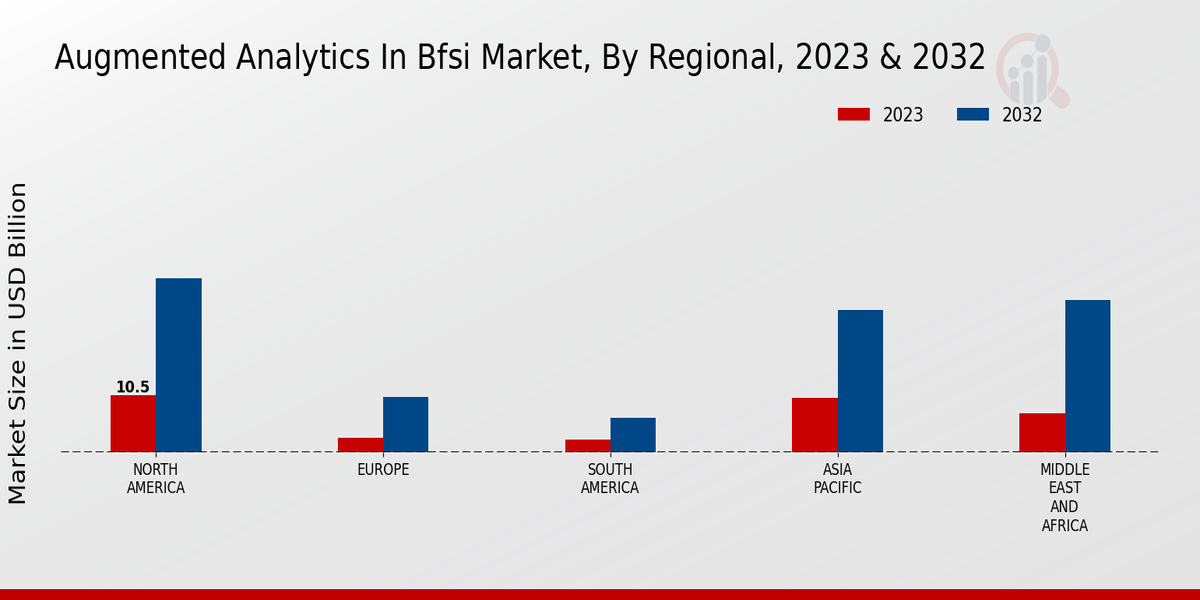Market Growth Projections
The Global Augmented Analytics In BFSI Market Industry is poised for substantial growth, with projections indicating a rise from 22.4 USD Billion in 2024 to 70.6 USD Billion by 2035. This trajectory reflects a compound annual growth rate (CAGR) of 11.0% from 2025 to 2035, highlighting the increasing adoption of augmented analytics solutions across the banking, financial services, and insurance sectors. The market's expansion is driven by various factors, including technological advancements, regulatory compliance, and the demand for enhanced customer experiences. As organizations continue to invest in data analytics capabilities, the industry is likely to witness transformative changes.
Integration of Cloud Computing Solutions
The integration of cloud computing solutions plays a pivotal role in the expansion of the Global Augmented Analytics In BFSI Market Industry. Cloud-based platforms enable financial institutions to access advanced analytics tools without the need for extensive on-premises infrastructure. This flexibility allows organizations to scale their analytics capabilities according to demand. Moreover, cloud solutions facilitate collaboration among teams, enhancing data sharing and analysis. As the industry adapts to technological advancements, the reliance on cloud computing is expected to increase, further contributing to the market's growth and innovation.
Regulatory Compliance and Risk Management
The necessity for stringent regulatory compliance and effective risk management strategies drives the Global Augmented Analytics In BFSI Market Industry. Financial institutions face increasing pressure to adhere to regulatory requirements while managing risks associated with financial transactions. Augmented analytics tools assist in monitoring compliance and identifying potential risks in real-time. For instance, banks utilize these tools to analyze transaction data for anomalies that may indicate fraudulent activities. As the industry evolves, the market is projected to expand to 70.6 USD Billion by 2035, underscoring the critical role of analytics in maintaining compliance and mitigating risks.
Rising Demand for Data-Driven Decision Making
The Global Augmented Analytics In BFSI Market Industry experiences a notable surge in demand for data-driven decision-making processes. Financial institutions increasingly recognize the value of leveraging data analytics to enhance operational efficiency and customer satisfaction. For instance, banks are utilizing augmented analytics to streamline risk assessment and improve fraud detection mechanisms. This trend is reflected in the projected market growth, with the industry expected to reach 22.4 USD Billion in 2024. The integration of advanced analytics tools enables organizations to derive actionable insights from vast datasets, thereby fostering a culture of informed decision-making.
Enhanced Customer Experience through Personalization
The Global Augmented Analytics In BFSI Market Industry is significantly influenced by the growing emphasis on enhancing customer experience through personalization. Financial institutions leverage augmented analytics to analyze customer data and tailor services to individual preferences. This approach not only improves customer satisfaction but also fosters loyalty and retention. For instance, banks utilize predictive analytics to offer personalized financial advice based on customer spending patterns. As the market continues to evolve, the integration of personalized services is likely to drive further growth, aligning with the industry's trajectory towards more customer-centric solutions.
Advancements in Artificial Intelligence and Machine Learning
Technological advancements in artificial intelligence and machine learning significantly propel the Global Augmented Analytics In BFSI Market Industry forward. These technologies facilitate the automation of data analysis, allowing financial institutions to process large volumes of information swiftly and accurately. For example, AI-driven algorithms can identify patterns in customer behavior, enabling personalized product offerings. The market is anticipated to grow at a CAGR of 11.0% from 2025 to 2035, indicating a robust adoption of AI and machine learning solutions. This evolution not only enhances operational capabilities but also positions organizations to respond proactively to market changes.

























